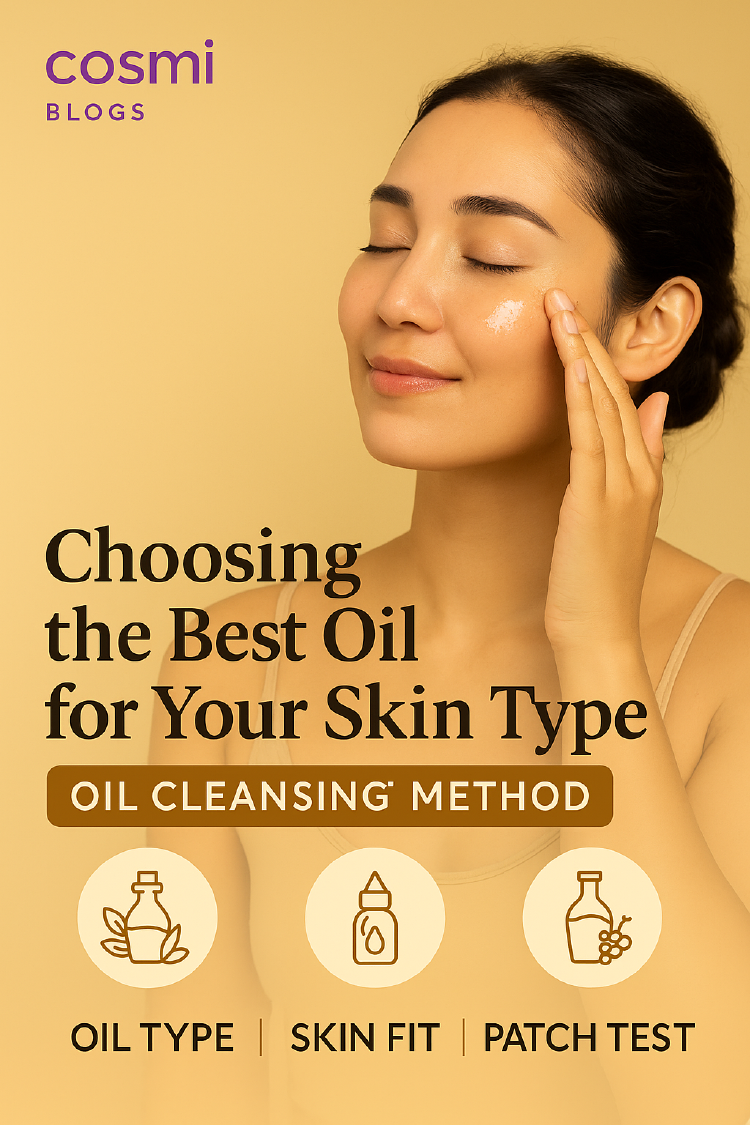Choosing the Best Oil for Your Skin Type Oil Cleansing Method
Navigate the world of OCM oils. Find the perfect oil based on comedogenicity, skin type, and personal results. Includes oil types & patch testing tips.

- Seo Yuna
- 5 min read

Choosing the Best Oil for Your Skin Type for Oil Cleansing Method
The Oil Cleansing Method (OCM) is a popular way to cleanse the skin using oils to dissolve makeup, sunscreen, and excess sebum. However, the success of OCM heavily relies on selecting the right oil for your individual skin needs. With a vast array of options available, it can feel daunting to know where to start. This guide provides insights and tips to help you navigate the choices.
Understanding Oil Properties and Your Skin
Not all oils are created equal. They vary in weight, texture, and the types of fatty acids they contain, which influences how they interact with your skin. A common concern is whether an oil will clog pores. This is often discussed in terms of comedogenicity.
Comedogenicity Ratings: A Guideline, Not a Rule
Oils are often assigned a comedogenicity rating from 0 (very unlikely to clog pores) to 5 (very likely to clog pores). While these ratings can be a useful starting point, it is crucial to understand that they are not absolute. An oil with a high rating might work perfectly for some individuals, while a supposedly non-comedogenic oil could cause breakouts for others. Personal experience and patch testing are the most reliable indicators.
Popular Oils and Their Characteristics
Here is a look at some oils frequently used for OCM, categorized by their general feel and typical comedogenicity profiles:
Generally Non-Comedogenic (Rating 0-1)
These are often recommended for those new to OCM or with easily congested skin, but individual reactions can still occur.
- Mineral Oil: Widely considered one of the safest and most effective starter oils. It is inert and has a comedogenicity rating of 0. Look for pure, fragrance-free mineral oil. Avoid products thickened with tocopherols or sold as laxatives.
- Sunflower Seed Oil: Lightweight and gentle, suitable for many skin types, including acne-prone.
- Safflower Seed Oil: Similar to sunflower oil, it is light and generally well-tolerated.
- Hemp Seed Oil: Known for its beneficial fatty acid composition and typically low comedogenicity.
Lighter to Moderately Comedogenic (Rating 1-3)
These oils can feel lovely but require careful patch testing as they are more likely to clog pores for some individuals.
- Grape Seed Oil: Very light in texture, sometimes described as slightly astringent. Can be somewhat drying for some.
- Olive Oil: Feels more moisturizing than lighter oils but has a higher likelihood of clogging pores. Ensure you source high-quality, pure oil.
- Sesame Oil: Requires careful patch testing due to its rating.
- Jojoba Oil: Structurally similar to human sebum. Many find it works well, but it can cause breakouts for some. It also functions effectively as a carrier oil.
- Apricot Kernel Oil: A light to medium weight oil that is moderately comedogenic for some.
Richer, More Moisturizing Oils (Rating 2-4)
These have a thicker consistency and are great for providing nourishment, particularly for dry or dehydrated skin, but pose a higher risk of clogging pores.
- Sweet Almond Oil: A nourishing oil with a pleasant texture, good for moisturizing.
- Avocado Oil: A richer oil that provides deep moisture. May not be as effective at breaking down heavy makeup compared to lighter oils.
- Argan Oil: Praised by some with very sensitive or particular skin as being highly effective and well-tolerated.
Oils Frequently Rated Highly Comedogenic (Rating 4-5)
These oils are most likely to cause issues, especially for those with a history of acne, but surprisingly work well for some individuals. Use with extreme caution and rigorous patch testing.
- Coconut Oil / Coconut Butter: While incredibly moisturizing and used successfully by some for OCM, it is widely considered highly comedogenic.
- Cocoa Butter: Also commonly rated as highly comedogenic.
- Soybean Oil
It is important to reiterate: Personal experiences with comedogenicity vary greatly. Do not rule out an oil solely based on its rating if you are willing to patch test it carefully. Some people with acne-prone skin successfully use oils like coconut oil, while others react to typically safe options like mineral oil.
Oils with Specific Benefits
Some oils offer additional therapeutic properties beyond basic cleansing:
- Castor Oil: Possesses antibacterial properties that can be beneficial for acne. Caution: Castor oil is very thick and can be drying. It should be diluted with a lighter carrier oil (like mineral or sunflower) before use for OCM or spot treatments (a common recommendation is 10-20% castor oil in a carrier oil). Never use undiluted on large areas.
- Tea Tree Oil (TTO): A potent antibacterial often used for acne. Extreme Caution: Tea tree oil is an essential oil and is highly concentrated. It must never be applied undiluted to the skin as it can cause severe irritation or chemical burns. Always dilute it heavily in a carrier oil (a common ratio is 1-2 drops per ounce of carrier oil) for spot treatment or OCM blends. Do not dilute with water for skin application as essential oils do not disperse properly in water alone.
- Neem Oil: Effective for acne and is not drying. It can be used undiluted as a spot treatment or mixed into OCM blends. Be aware it has a strong, distinctive odor.
- Evening Primrose Oil: Some find it helpful for hormonal breakouts. It also shows promise in supporting skin barrier function and may be beneficial for conditions like eczema, though medical consultation is advised for treating such conditions.
Essential Tips for OCM Oil Selection
- Quality and Purity: Look for oils that are 100% pure. Terms like
Unlock Your Healthiest Skin – Backed by Science and Personalization
Cosmi is your personal AI cosmetologist — offering tailored skincare recommendations and expert advice based on your unique skin type, concerns, and goals.
Visit Cosmi